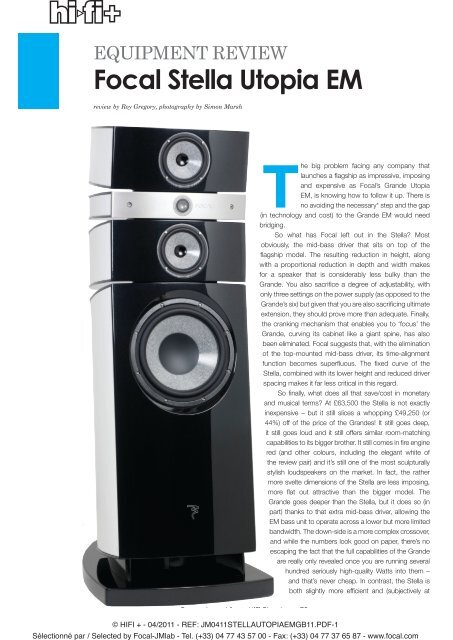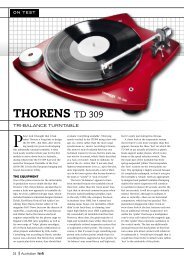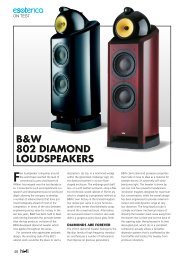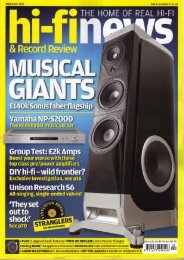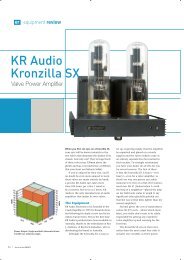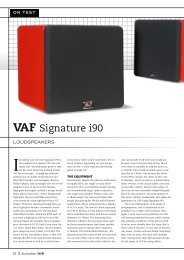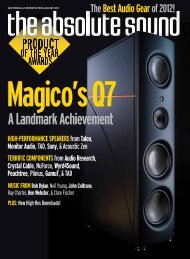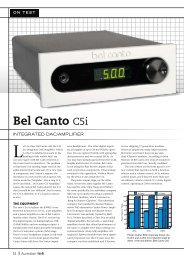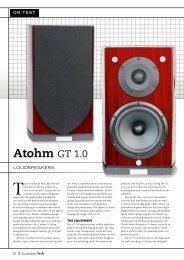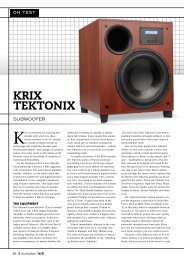EquipmEnt REviEw Focal Stella Utopia EM - EXCELIA HIFI
EquipmEnt REviEw Focal Stella Utopia EM - EXCELIA HIFI
EquipmEnt REviEw Focal Stella Utopia EM - EXCELIA HIFI
Create successful ePaper yourself
Turn your PDF publications into a flip-book with our unique Google optimized e-Paper software.
<strong>EquipmEnt</strong> <strong>REviEw</strong><br />
<strong>Focal</strong> <strong>Stella</strong> <strong>Utopia</strong> <strong>EM</strong><br />
review by Roy Gregory, photography by Simon Marsh<br />
Reproduced from HiFi Plus, Issue 79<br />
www.hifiplus.com<br />
© <strong>HIFI</strong> + - 04/2011 - REF: JM0411STELLAUTOPIA<strong>EM</strong>GB11.PDF-1<br />
The big problem facing any company that<br />
launches a flagship as impressive, imposing<br />
and expensive as <strong>Focal</strong>’s Grande <strong>Utopia</strong><br />
<strong>EM</strong>, is knowing how to follow it up. There is<br />
no avoiding the necessary* step and the gap<br />
(in technology and cost) to the Grande <strong>EM</strong> would need<br />
bridging.<br />
So what has <strong>Focal</strong> left out in the <strong>Stella</strong>? Most<br />
obviously, the mid-bass driver that sits on top of the<br />
flagship model. The resulting reduction in height, along<br />
with a proportional reduction in depth and width makes<br />
for a speaker that is considerably less bulky than the<br />
Grande. You also sacrifice a degree of adjustability, with<br />
only three settings on the power supply (as opposed to the<br />
Grande’s six) but given that you are also sacrificing ultimate<br />
extension, they should prove more than adequate. Finally,<br />
the cranking mechanism that enables you to ‘focus’ the<br />
Grande, curving its cabinet like a giant spine, has also<br />
been eliminated. <strong>Focal</strong> suggests that, with the elimination<br />
of the top-mounted mid-bass driver, its time-alignment<br />
function becomes superfluous. The fixed curve of the<br />
<strong>Stella</strong>, combined with its lower height and reduced driver<br />
spacing makes it far less critical in this regard.<br />
So finally, what does all that save/cost in monetary<br />
and musical terms? At £63,500 the <strong>Stella</strong> is not exactly<br />
inexpensive – but it still slices a whopping £49,250 (or<br />
44%) off of the price of the Grandes! It still goes deep,<br />
it still goes loud and it still offers similar room-matching<br />
capabilities to its bigger brother. It still comes in fire engine<br />
red (and other colours, including the elegant white of<br />
the review pair) and it’s still one of the most sculpturally<br />
stylish loudspeakers on the market. In fact, the rather<br />
more svelte dimensions of the <strong>Stella</strong> are less imposing,<br />
more flat out attractive than the bigger model. The<br />
Grande goes deeper than the <strong>Stella</strong>, but it does so (in<br />
part) thanks to that extra mid-bass driver, allowing the<br />
<strong>EM</strong> bass unit to operate across a lower but more limited<br />
bandwidth. The down-side is a more complex crossover,<br />
and while the numbers look good on paper, there’s no<br />
escaping the fact that the full capabilities of the Grande<br />
are really only revealed once you are running several<br />
hundred seriously high-quality Watts into them –<br />
and that’s never cheap. In contrast, the <strong>Stella</strong> is<br />
both slightly more efficient and (subjectively at<br />
Sélectionné par / Selected by <strong>Focal</strong>-JMlab - Tel. (+33) 04 77 43 57 00 - Fax: (+33) 04 77 37 65 87 - www.focal.com
<strong>EquipmEnt</strong> <strong>REviEw</strong> / <strong>Focal</strong> <strong>Stella</strong> <strong>Utopia</strong> <strong>EM</strong> loudspeaker<br />
least) a significantly less demanding load, making it easier on your system and<br />
in turn, making your system easier on your pocket. The <strong>Stella</strong> isn’t just cheaper<br />
to buy than the Grande, it’s cheaper to run too.<br />
I ran the <strong>Stella</strong> with a whole host of partnering amps, including a couple of<br />
high-quality but relatively modest integrateds, just to see what would happen.<br />
Even the Storm Audio V35’s 70 solid-state Watts were more than capable<br />
of raising music from the <strong>Stella</strong>s. Sure, the Berning monos delivered greater<br />
texture, detail and transparency, the VTL 450s considerably more colour and<br />
authority, but the <strong>Stella</strong>s seem to shine a light on their partner’s strengths –<br />
rather than exposing their weaknesses.<br />
Set up is surprisingly straightforward for a speaker of this size and weight,<br />
and while I allowed them plenty of room to breathe, their adjustability will make<br />
them more tolerant of cramped accommodation than many speakers of this<br />
size and bandwidth. Do remove the grilles and do tighten the driver mounting<br />
bolts. Other than that it’s just about getting the position and settings right, for<br />
which a little experienced help will be invaluable.<br />
Confronted with the <strong>Stella</strong>s, it’s almost inevitable that your first impulse<br />
will be along the lines of, “Well, let’s see what the bass is like?” It’s a big<br />
speaker and it should go low, especially given the <strong>EM</strong> driver. Well, it does –<br />
and in emphatic fashion. But what is more interesting is how the low frequency<br />
extension affects the musical presentation.<br />
The <strong>Stella</strong> cannot match the scale and soundstage dimensionality of its<br />
bigger brother. In real terms, it’s far from a slouch in this regard, but it doesn’t<br />
possess the clear delineation of soundstage boundaries, the breadth and<br />
depth, the three-dimensionality of individual instruments that the Grande is<br />
capable of. Take the Petrenko Shostakovich 11th Symphony as an example.<br />
The <strong>Stella</strong>s’ soundstage is big, with good width and depth. But compared to<br />
the Grande, it doesn’t extend as far outside the speakers, and doesn’t end in<br />
a definite boundary. The timps and snare drum in the opening aren’t located<br />
precisely relative to the rear wall, the trumpet call isn’t surrounded by its own<br />
cushion of air. What does this mean in musical terms? In absolute terms,<br />
it robs this most atmospheric of symphonic openings of that last ounce of<br />
tension and chill, the ability that the bigger speaker has to pull you, almost<br />
bodily into the recording. Less obviously, it also lacks the absolute fluidity of<br />
pace and tempo that the Grandes can deliver.<br />
Take a listen to This One’s For Blanton and you’ll hear the same effects<br />
on a smaller, more intimate recording. Played on the <strong>Stella</strong>, the presentation<br />
lacks the explicit placement of bass and piano, both in depth and height,<br />
while the astonishing rhythmic elasticity that flows between Ellington and Ray<br />
Brown is curtailed in its sheer expressive range. Instead, the playing is tighter,<br />
more driven, more locked in. Now consider that in the <strong>Stella</strong> the <strong>EM</strong> driver,<br />
with its incredibly powerful and responsive motor, coupled to a peak to peak<br />
extension of 36mm, is responsible for the range all the way up to 220Hz. No<br />
wonder the <strong>Stella</strong>’s low frequencies enjoy such attack and clarity of note to<br />
note separation. Ironically, the <strong>EM</strong> driver in the <strong>Stella</strong> might be smaller than<br />
the one in the Grande, but it’s influence is wider ranging and could actually be<br />
considered more important. These are essentially the differences that you’d<br />
expect between a genuinely full-range design and one that just goes deep, but<br />
the equation is far from being entirely on the debit side, especially once you<br />
place both designs in context.<br />
The <strong>Stella</strong> is a far less demanding beast,<br />
especially of space and matching equipment.<br />
Its potential performance at the bottom end<br />
might not match the Grande, but I’d rather<br />
have all of the <strong>Stella</strong> than some of the Grande.<br />
Also, factor that more purposeful, directed<br />
presentation into proceedings and you<br />
quickly discover that, even if it lacks that last<br />
ounce of “you are there” frisson that comes<br />
with the Grande, it makes for an undeniably<br />
compelling physical performance. What<br />
extra bass does come out of the Grandes<br />
has more to do with space and the acoustic<br />
than the notes from the instruments. Just<br />
listen to the mounting, climactic waves that<br />
carry the second and fourth movements<br />
and you’ll hear exactly what I mean. There’s<br />
no shortage of orchestral weight and no<br />
diminution of the sheer musical power that<br />
Petranov conjures from the score and the<br />
Liverpool Philharmonic, which given the<br />
music in question, is no mean feat!<br />
*Necessary, because flagship models are expensive to produce, expensive to buy and remain for the vast majority, an unattainable dream. “Why bother then?” I hear<br />
you ask: because they serve as development platforms and attention grabbers, generating “trickle down” products and sales. So, for every pair of Nautilus 800Ds<br />
they sell, B&W will look to sell at least ten pairs of 802Ds. Likewise, in smaller numbers, the Wilson Audio X2 and Maxx 3 – or of course, the <strong>Focal</strong> Grande <strong>Utopia</strong><br />
<strong>EM</strong> and the <strong>Stella</strong>…<br />
Reproduced from HiFi Plus, Issue 79<br />
© <strong>HIFI</strong> + - 04/2011 - REF:<br />
www.hifiplus.com<br />
JM0411STELLAUTOPIA<strong>EM</strong>GB11.PDF-2<br />
Sélectionné par / Selected by <strong>Focal</strong>-JMlab - Tel. (+33) 04 77 43 57 00 - Fax: (+33) 04 77 37 65 87 - www.focal.com
<strong>EquipmEnt</strong> <strong>REviEw</strong> / <strong>Focal</strong> <strong>Stella</strong> <strong>Utopia</strong> <strong>EM</strong> loudspeaker<br />
So, while there are very real differences between the bottom end of the<br />
<strong>Stella</strong> and its more expensive, older brother, for most of us, either practicality<br />
or taste will render them irrelevant. But, whilst bass presentation and power are<br />
key to the sound of this speaker, certainly in commercial terms, it’s only half of<br />
the story. What really impresses me about the way they play the Shostakovich<br />
11th is their ability to transit from shatteringly loud to the quietest, most fragile<br />
phrase without hangover, spatial or dynamic collapse. The score takes you<br />
from fff straight to ppp without hesitation, deviation or repetition, one musical<br />
phrase growing literally from the decay roots of the other. Live, it’s a shatteringly<br />
emotive effect and the <strong>Stella</strong> is one of the very few speakers that has both the<br />
bandwidth and the unfettered dynamic range to pull it off convincingly. Where<br />
other systems make the transition more of a slope, less of a cliff, the <strong>Stella</strong>s<br />
give you Beachy Head, complete with the impact as you hit the bottom!<br />
This ability to play genuinely loud, without placing such a strain on the<br />
amplifier that the orchestra congeals into a single, screeching mess, combined<br />
with the tactile microdynamic immediacy that holds the quietest passages<br />
together allows the <strong>Stella</strong>s to run the full musical gamut, from quiet to loud as<br />
well as quiet and loud. Their ability to hold separate the quieter instruments,<br />
maintaining their integrity in the face of much larger forces, is bettered only<br />
by the likes of the Grande and other speakers in that class. Just listen to the<br />
opening of ‘Way Out Basie’ (Farmers Market Barbeque) and you’ll note the<br />
guitar, quietly strumming along with the rhythm section. Now ask yourself how<br />
clearly you can hear it under the brass tuttis? With the <strong>Stella</strong>s it’s a quietly<br />
confident and constant presence, locked in space behind the piano. Likewise,<br />
the impromptu backing vocals and noises off (dog barking, mechanicals) that<br />
accompany Townes Van Zandt on ‘Waitin’ Round To Die’ are crystal clear<br />
parts of the whole, without distracting from it.<br />
That impressive weight and power that gives the Shostakovich such<br />
musical and emotional authority underpins the fact that the <strong>Stella</strong>s’ agility and<br />
detail isn’t won at the expense of tonal colour and harmonic complexity. The<br />
conversational give and take of Mozart’s Sinfonia Concertante K.364 is built<br />
on the contrasting voices of violin and viola. It’s amazing how many speakers<br />
confuse or fail to separate the two instruments, yet the <strong>Focal</strong>s keep that<br />
separation clear, even when the two are playing in unison. The viola’s richer,<br />
woodier tone is unmistakable, as is the characteristic colour of the cor anglais,<br />
in the hauntingly fragile and evocative solo passage that graces the fourth<br />
movement of the Shostakovich. And when that mighty performance crashes<br />
to a close, the accusing tone of the bell’s final toll rings on – and rings true.<br />
Tracks that depend on their measured pace (Janis Ian’s ‘Some People’s<br />
Lives’, for instance) lose a little of the pathos, but make up for it in terms<br />
of intensity and purpose, while those tracks that demand drive and energy<br />
take on a whole new life and energy. Everything from Elvis Costello and Steve<br />
Earle concert tapes to the Cure’s Head On The Door were let off the leash,<br />
to impressively compelling effect. Volumes were advanced and sessions<br />
extended, but the <strong>Stella</strong>s took it all in their stride.<br />
Which invites the question, leaving aside sibling rivalry, just how do they<br />
compare to the likes of Avalon’s Time and Nola’s Baby Grand?<br />
Of those two, the Time is both the better balanced and the more serious<br />
competition. Capable of matching the fit, finish and engineering/technology<br />
content of the <strong>Stella</strong>, it offers a distinctly<br />
different musical presentation as well as<br />
a smaller and less dramatic physical one.<br />
Tonally, the accuracy and richness of its<br />
palette eclipses the otherwise impressive<br />
capabilities of the <strong>Stella</strong> in this regard, and<br />
it has a poise and easy precision that is<br />
both engaging and musically seductive.<br />
Where it loses out to the French speaker is<br />
in the demands it places on the partnering<br />
amplifier, and even when those are met, in<br />
its ability to track the dynamic demands of<br />
the performance. The <strong>Stella</strong> can simply jump<br />
further – and faster.<br />
But each time the Avalon shades the<br />
<strong>Stella</strong> in one regard, the <strong>Focal</strong> responds in<br />
another. Both are truly exceptional speakers,<br />
offering a level of performance I wouldn’t have<br />
thought possible not so long ago. Which of<br />
these speakers you’d prefer is going to be a<br />
largely personal choice. Let’s take the top-end<br />
as an example. Would you opt for the purity<br />
and incredibly natural tonality of the Avalon’s<br />
diamond tweeter, or the immediacy, energy<br />
and speed of the <strong>Focal</strong>’s beryllium? Both are<br />
exceptional, both integrate beautifully with<br />
the rest of the design they grace – but the<br />
benefits are quite distinct, and in the case<br />
of the <strong>Focal</strong>, which is after all the speaker<br />
under review, they lean towards excitement<br />
and drama. If you like your music live, then<br />
look no further.<br />
Which brings us to the area in which the<br />
<strong>Stella</strong>s truly excel. Just like the Time, they<br />
are able to project musical energy evenly<br />
across the entire range, from their deepest<br />
bass to beyond audibility at the high end.<br />
It makes them seamless in presentation,<br />
allowing them to step back behind the<br />
performance, allowing the music to speak<br />
for itself. Impressive enough, except that the<br />
<strong>Stella</strong> takes this to a new level, exceeding in<br />
my estimation, even the ability of the Grande<br />
in this regards. Maybe it’s the smaller bass<br />
unit, maybe it’s the slightly higher efficiency<br />
and I’m sure it has a lot to do with giving<br />
the driving amp an easier job, but when<br />
the music (and amp) says “jump”, the <strong>Stella</strong><br />
simply says, “How High?”<br />
Reproduced from HiFi Plus, Issue 79<br />
www.hifiplus.com<br />
© <strong>HIFI</strong> + - 04/2011 - REF: JM0411STELLAUTOPIA<strong>EM</strong>GB11.PDF-3<br />
Sélectionné par / Selected by <strong>Focal</strong>-JMlab - Tel. (+33) 04 77 43 57 00 - Fax: (+33) 04 77 37 65 87 - www.focal.com
<strong>EquipmEnt</strong> <strong>REviEw</strong> / <strong>Focal</strong> <strong>Stella</strong> <strong>Utopia</strong> <strong>EM</strong> loudspeaker<br />
The effect (and benefit) is so obvious, so unusual, that they’re apparent<br />
whatever you play. Try Beausoleil’s ‘Zydeco Gris Gris’ (I know, but you’ll find it<br />
on the excellent Big Easy OST); It has exactly the kind of tub-thumping bass<br />
that becomes a one-note thud on most speakers. On the <strong>Stella</strong>s, the notes<br />
don’t just have pitch and shape – which is remarkable enough – but they<br />
actually project too, pushing the track along, rather than dragging it back.<br />
Meanwhile, the rattles and brushwork at the other extreme are just as clean<br />
and purposeful, insistent without ever being intrusive. It is just apparent on<br />
more poised and controlled material too, bringing new illumination to Julia<br />
Fischer’s precision and technical virtuosity, further revealing how that technique<br />
is harnessed to the musical whole, while the astonishing control of Zinka<br />
Milanov, even past her best, is clear to hear.<br />
If power, weight and impact are high on the list of <strong>Stella</strong> attributes, it’s<br />
voices that really bring this speaker’s strengths together. Familiar voices are<br />
instantly recognisable, so Eleanor McEvoy’s accent and contralto pitching,<br />
the particular slant they give her sardonic social snapshots, carry you straight<br />
back to her live delivery. It’s an effect that’s reinforced by the sheer presence<br />
and lifelike scale that the <strong>Stella</strong> invests in its images. This is no pint-sized<br />
facsimile of the real event. The speaker’s height and its ability to project energy<br />
creates solid, substantial images that both convince and reveal the degree to<br />
which most speakers scale down the musical event – both in physical and<br />
dynamic terms. This is about big, bold musical presence; if it’s on the disc<br />
then the <strong>Stella</strong>s will project it into your room. It makes great live recordings (like<br />
Elvis Costello Live At The el Mocambo) an almost visceral experience – just<br />
like they were. When the Attractions pile into a gloriously over the top ‘Pump It<br />
Up’ it sets the whole room jumping – just like it was! Costello’s laconic, almost<br />
deadpan delivery provides the perfect foil to the tight, frenetically driven energy<br />
of tracks like ‘Mystery Dance’ and ‘You Belong To Me’. When the music gets<br />
out of control it’s because the band takes it there, rather than because the<br />
speakers lose their grip on proceedings.<br />
Indeed, beside the discussion of what the <strong>Stella</strong>s don’t do there’s the<br />
parallel issue of just how they do do what they do do; the mark they leave on<br />
the musical performance. It’s perhaps most easily understood as an underlying<br />
attitude, the speakers giving the performance a forward facing stance. In the<br />
same way that, by the highest possible standards, they rob the acoustic of a<br />
little space, they almost seem to pull in the temporal verges too, leaving the<br />
players a little less latitude. But that’s the price<br />
you pay for their ability to react so fast and so<br />
emphatically to the dynamic demands of the<br />
signal they receive, and for many a listener it<br />
will be a trade-off they are more than happy<br />
to make, a trade-off that’s less intrusive, less<br />
musically emasculating than those chosen<br />
by other speaker designs.<br />
And that’s the key to the <strong>Stella</strong>; what you<br />
get (in musical terms) for what you pay (in<br />
cost and system terms). For of all the serious<br />
contenders in this price bracket, the <strong>Focal</strong><br />
offering not only provides a unique blend of<br />
virtues – and “me too” really isn’t an option<br />
at this point in the market – that potential<br />
is by far the easiest to realize in practice.<br />
Adjustable and drivable, not only is the <strong>Stella</strong><br />
more amenable than most of the competition<br />
to less than perfect rooms, the bill for the<br />
driving amps is likely to be lower too. When it<br />
comes to scaling down the Grande <strong>Utopia</strong>s,<br />
<strong>Focal</strong> have got their mix spot on: Practicality<br />
and commonsense infecting a genuinely<br />
high-end product? Whatever next… +<br />
TEchnical<br />
SpEciFicaTionS<br />
Type: Floorstanding three-way, reflex<br />
loaded loudspeaker system<br />
Driver Complement: 1x 27mm inverted<br />
Beryllium dome HF, 2x 165mm W<br />
sandwich MF, 1x 330mm W sandwich,<br />
electro-magnetic LF<br />
Connections: Bi-wire inputs for signal<br />
IEC power connection for bass unit<br />
Bandwidth: 22Hz – 40kHz ±3dB<br />
Sensitivity: 94dB<br />
Nominal Impedance: 8 Ohms<br />
Minimum Impedance: 2.8 Ohms<br />
Crossover Frequencies: 220Hz and<br />
2200Hz<br />
Dimensions (WxHxD): 553 x 1558 x<br />
830mm<br />
Weight: 165kg ea.<br />
Price: £63,500 per pair<br />
Manufactured by: <strong>Focal</strong><br />
URL: www.focal.com<br />
Distributed by: <strong>Focal</strong> UK<br />
Tel: +44(0) 845 660 2680<br />
Reproduced from HiFi Plus, Issue 79<br />
www.hifiplus.com<br />
© <strong>HIFI</strong> + - 04/2011 - REF: JM0411STELLAUTOPIA<strong>EM</strong>GB11.PDF-4<br />
Sélectionné par / Selected by <strong>Focal</strong>-JMlab - Tel. (+33) 04 77 43 57 00 - Fax: (+33) 04 77 37 65 87 - www.focal.com


